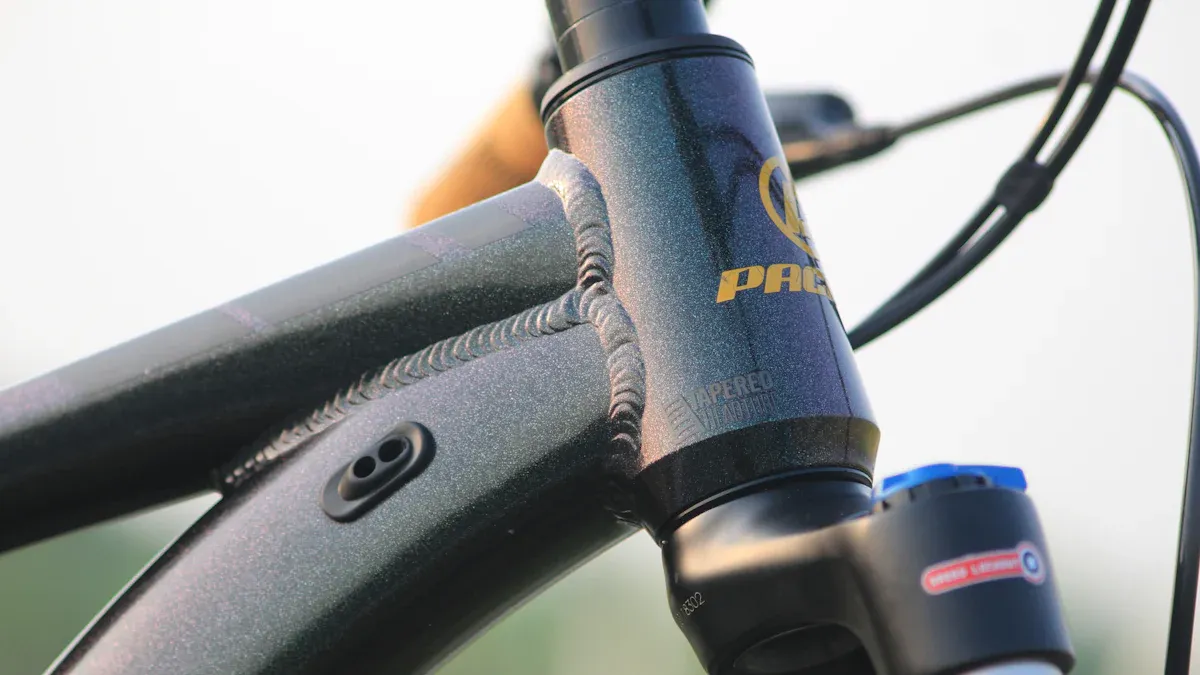
Fork compatibility with bike frame tapered head tubes is very important for your bike’s performance and safety. Many new bicycles, especially performance models, feature tapered head tubes. This design improves handling and stability, making it especially helpful under the forces from disc brakes and rough terrains. One study indicates that a tapered head tube directs forces better to the fork’s crown, reducing the movement found in straight steer tubes. Therefore, you should consider your bike’s specifications before making any purchases. This will help ensure the best performance on your rides.
Key Takeaways
Tapered head tubes make bikes more stable and easier to control. This is great for performance bikes.
Picking the right fork is very important. Make sure it fits your bike’s tapered head tube for the best performance.
Adapters can help connect straight forks to tapered head tubes. This gives you more choices without losing performance.
Always read the manufacturer’s instructions. This helps ensure your bike frame and fork work well together for a safe ride.
Buying a tapered head tube improves your bike’s performance and allows for upgrades.
What is a Tapered Head Tube?

A tapered head tube is an important part of modern bike design. It has a wider bottom than the top. This shape makes the bike more stable and easier to handle. That’s why many performance bikes use it. The tapered head tube fits a bigger tapered fork. This helps create a ride that feels more responsive.
Advantages of Tapered Head Tubes
Tapered head tubes have many benefits that can greatly improve your biking experience:
Increased Strength: The design allows for larger headset bearings. This spreads stress over a larger area. It makes the frame stronger and lasts longer. You will feel better stiffness, making your bike tougher against stress.
Better Handling: With a tapered head tube, you get better control of your bike. This design gives you a more stable ride. It is especially helpful on rough paths or sharp turns. Many cyclists say tapered head tubes are much more stable than non-tapered ones.
Improved Load Distribution: Using larger downtubes with tapered head tubes makes the frame stiffer. It also helps it carry more weight. This means you can take on tough rides with confidence, knowing your bike can handle it.
Enhanced Performance: Tapered head tubes are now common in mid-to-high-end bikes. About 65% of these bikes use them. This shows that more people want stronger bikes that perform better, especially in BMX.
Here’s a quick look at the most common sizes for tapered head tubes in the bike industry:
Size (mm) | Common Range |
|---|---|
100 | Starting point |
110 | Incremental size |
120 | Incremental size |
130 | Upper limit for common sizes |
Fork Specs for Tapered Head Tubes

When you pick a fork for your bike with a tapered head tube, knowing the specs is very important. Tapered head tubes need special fork designs. This ensures they work well together and perform at their best.
Steerer Tube Dimensions
You will see different types of forks that fit tapered head tubes. The most common types are:
Straight 1-⅛ Forks: These forks have the same size all the way.
Tapered Forks: These start wider at the bottom and get smaller at the top. They usually measure 1-¼ inches at the bottom and 1-⅛ inches at the top.
Tapered 1-½ Forks: These are made for bigger head tubes. They give more strength and stability.
To help you understand the compatibility, here’s a table showing the crown race seat sizes for different fork steerer types:
Fork Steerer Type | Crown Race Seat Diameter |
|---|---|
Straight 1-⅛ | 30mm |
Tapered 1-¼ | 33mm |
Tapered 1-½ | 40mm |
The size of your head tube is very important. It helps decide the headset style and fork steerer tube fit. There are three main types of head tube standards:
External Cup: This is the old style. The headset cups are pressed outside the head tube.
Zero Stack/Internal: The headset cups go into the frame. This gives a cleaner look.
Integrated: This is a modern design. The bearings sit directly in the frame’s built-in spots.
When you choose a new gravel fork, make sure the steerer tube is longer than you need. This lets you cut it to the right length for your bike. It’s smart to cut the steerer tube a few centimeters longer than you think. This extra length helps make sure it fits well.
Compatibility Factors for Tapered Head Tubes
When you choose a fork for your bike with a tapered head tube, there are some important factors to consider. Knowing these factors helps you make good choices and avoid problems.
Using Adapters for Compatibility
The angle of the head tube affects how your bike rides. A steeper angle helps you climb better. It makes the back end shorter, so your bike feels quicker. On the other hand, a shallower angle with more rake gives you better stability on bumpy paths. You might notice these changes when you switch bikes.
For the steerer tube diameter, make sure the fork matches your bike’s size. Most tapered head tubes need a steerer tube size between 1-1/8″ and 1-1/2″. This size ensures a secure fit and good performance. If you have a straight 1-1/8″ steerer fork, you can use an adapter for the lower bearing. This option helps you find the right fork without losing performance.
Using the right crown race is very important too. An incorrect crown race can cause steering problems. You might feel binding before the headset is tight enough to stop movement. To avoid this, always use the crown race that comes with your headset.
Here’s a quick reference table for fork and head tube compatibility:
Requirement | Details |
|---|---|
Total Steerer Tube Length | 183-230mm (7.25-9.00″) |
Steerer Tube Star Nut Diameter | 24.25 mm-24.80 mm |
Steerer Tube Min Diameter | 22.1 mm (0.87″) |
Steerer Tube Max Diameter | 31.75 mm – 34.00 mm (1.25-1.34″) |
Always check these sizes when you replace your fork. This makes sure your new fork fits well and keeps the bike’s original shape. Good compatibility helps you get the handling and performance you want.
Choosing the Right Fork for Your Bike Frame Tapered Head Tube
When you pick a fork for your bike frame tapered head tube, think about a few important things. First, look at your bike’s shape and what it needs. This helps you find a fork that makes your bike work better.
Checking Manufacturer Guidelines
Checking manufacturer guidelines is very important. They give you details about different head tube types and which forks fit. Here are some key steps to follow:
Make sure the fork fits the head tube and pick the right headset using the frame maker’s guide.
Choose a fork that matches the bike frame’s travel specs, usually within ~20mm.
Pick a stem and handlebar that fit the fork’s size.
Select wheels that match the frame’s size and hub specs.
Decide on the drivetrain, making sure all parts work with the same speed system.
Also, measure the axle-to-crown length. This affects how your bike handles. The rake (or offset) is also important for good handling and stability.
Here’s a quick reference table for head tube types and their compatibility:
Headtube Type | Fits Steerers | Compatibility |
|---|---|---|
EC34/EC44 mm | 1.125″, 1.125″-1.250″, 1.125″-1.500″ | 1.125″ EC, 44 mm EC + ZS headset |
IS41/IS52 mm | 1.125″-1.500″ | IS41 and IS52 mm headset |
EC37/EC37 mm | 1.125″-1.250″ | IS37 mm headset |
By following these steps, you can make sure your new fork fits well and keeps the bike’s original shape. Good compatibility helps you get the handling and performance you want.
In short, making sure your fork fits tapered head tubes is very important for your bike’s safety and performance. Here are some main benefits to think about:
Advantage | Explanation |
|---|---|
Future-proofing | Using a tapered head tube keeps up with new technology. It also makes sure it works with modern suspension forks. |
Performance enhancement | Most top-quality suspension forks only come in a tapered steerer style. This opens up new upgrade options. |
Versatility | Adapters can change a regular fork to fit a tapered head tube. This gives you more choices and better compatibility. |
Avoid common mistakes by knowing taper lengths and checking the fit. Take time to research and ask experts if needed. Your bike deserves the best for great riding experiences! 🚴♂️
FAQ
What is the difference between a tapered head tube and a straight head tube?
A tapered head tube is wider at the bottom and narrower at the top. This shape helps with stability and handling. A straight head tube stays the same size all the way up, which might not give the same benefits.
Can I use a straight fork with a tapered head tube?
Yes, you can use a straight fork with a tapered head tube if you have an adapter. This adapter helps the straight fork fit well. Just make sure it does not affect performance or handling.
How do I measure my bike’s head tube?
To measure your bike’s head tube, use a caliper or ruler. Measure the size at the top and bottom of the tube. This will help you find the right fork and headset that fit.
What should I consider when upgrading my fork?
When upgrading your fork, think about the steerer tube length, size, and travel specs. Make sure the new fork fits your bike’s shape and what you plan to use it for to get the best performance.
Are tapered head tubes worth the investment?
Yes, tapered head tubes improve bike performance, stability, and handling. They help spread weight better and allow for stronger forks. Spending money on a tapered head tube can really make your rides better. 🚴♂️
See Also
Understanding Bike Frame Components And Their Roles
Simplifying Large Sizing And Geometry For Mountain Bikes
Key Factors To Consider When Evaluating Bike Dimensions
